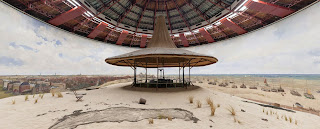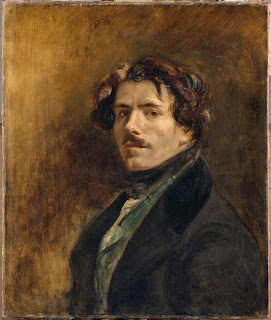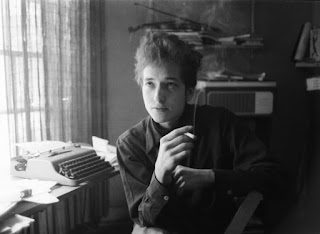Panorama Mesdag painting of approximately 120 meters.
Panorama Mesdag is a cylindrical painting of approximately 14 meters high and with a circumference of 120 meters. The painting, which is one of the oldest 19th century panoramas in the world, is a view of the North Sea, the dunes, The Hague and Scheveningen. It belongs to the 'Top 100 of the National Heritage Agency' from 1990.
It was painted in 1881 by Hendrik Willem Mesdag, a famous painter from the Hague School. He specialized in painting seascapes. His wife Sientje Mesdag-van Houten and the painters Théophile de Bock, George Hendrik Breitner and Bernard Blommers also made a significant contribution.
Panorama Mesdag dates back to a period in which many panoramas appeared in Europe. Apart from the existing paintings, this was a way of popular entertainment in the 19th century. It was one of the limited possibilities to get a realistic look at a situation elsewhere. Almost 100 years before the emergence of Panorama Mesdag, the first semi-permanent building was erected in London in which a panoramic view was exhibited. It was Robert Barker who built the Rotunda in Leocaster Square in London in 1793. With a low entrance fee and high visitor numbers, Barker made a fortune with this.
This also encouraged others to make such panoramas, either traveling around or in permanent buildings. A temporary panorama in Amsterdam 'The Battle of Algiers' attracted nearly 54 thousand visitors in 1826. With access prices between 50 cents and 1 guilder it was a lucrative business.
In Amsterdam, the Panorama Building was opened in 1880 at the Plantage Middenlaan. During the same period it also emerged that part of the audience was already familiar with panoramas; the new one was finished. Already ten years after opening, the Amsterdam panorama building came into financial difficulties.
In 1881, at the Bezuidenhout in The Hague, the Panorama Wouters opened with the Panorama of Cairo painting as the first in The Hague. It was not new and had previously served in Paris and Brussels.
According to some [1] the Panorama Mesdag served as a speculation object and that in a period when the height of panoramas was already reached. Although the number of visitors was fairly conservative (30,000), the first company as mentioned below, soon went bankrupt
At the top of the Seinpostduin, at that time the highest dune of Scheveningen, the view of a glass cylinder was drawn on the spot. By putting paper around it, a flat representation could be made. By placing a light source in the middle of the cylinder, the scene could also be projected on the canvas.
The glass cylinder that was used at the time to paint the panorama is still in the middle.
After all preparations were completed, Mesdag and his assistants took another four months to paint the artwork. Théophile de Bock mainly focused on the sky and the dunes, Breitner painted the cavalry that is practicing on the beach and Blommers was responsible for the mother with her daughter who watched behind the fence. Sientje Mesdag painted the village Scheveningen together with Breitner. Mesdag himself occupied himself with the boats and the sea.
On the panorama Mesdag painted his wife Sientje instead of a signature that is common on panorama paintings. She is sitting on the beach under a white parasol in front of her easel between the bombers.
Mesdag initially commissioned the painting for a Belgian company. This company went bankrupt and Mesdag, who was not an average, then bought it back. Mesdag and his wife had no children since their only son Klaas died in 1871. Even before his death, Mesdag donated the Panorama to his 33 cousins and nieces in the form of an NV. Panorama Mesdag is still managed by the descendants of the original shareholders, now as cultural-historical family BV.
Kind regards Pierre
It was painted in 1881 by Hendrik Willem Mesdag, a famous painter from the Hague School. He specialized in painting seascapes. His wife Sientje Mesdag-van Houten and the painters Théophile de Bock, George Hendrik Breitner and Bernard Blommers also made a significant contribution.
Panorama Mesdag dates back to a period in which many panoramas appeared in Europe. Apart from the existing paintings, this was a way of popular entertainment in the 19th century. It was one of the limited possibilities to get a realistic look at a situation elsewhere. Almost 100 years before the emergence of Panorama Mesdag, the first semi-permanent building was erected in London in which a panoramic view was exhibited. It was Robert Barker who built the Rotunda in Leocaster Square in London in 1793. With a low entrance fee and high visitor numbers, Barker made a fortune with this.
This also encouraged others to make such panoramas, either traveling around or in permanent buildings. A temporary panorama in Amsterdam 'The Battle of Algiers' attracted nearly 54 thousand visitors in 1826. With access prices between 50 cents and 1 guilder it was a lucrative business.
In Amsterdam, the Panorama Building was opened in 1880 at the Plantage Middenlaan. During the same period it also emerged that part of the audience was already familiar with panoramas; the new one was finished. Already ten years after opening, the Amsterdam panorama building came into financial difficulties.
In 1881, at the Bezuidenhout in The Hague, the Panorama Wouters opened with the Panorama of Cairo painting as the first in The Hague. It was not new and had previously served in Paris and Brussels.
According to some [1] the Panorama Mesdag served as a speculation object and that in a period when the height of panoramas was already reached. Although the number of visitors was fairly conservative (30,000), the first company as mentioned below, soon went bankrupt
At the top of the Seinpostduin, at that time the highest dune of Scheveningen, the view of a glass cylinder was drawn on the spot. By putting paper around it, a flat representation could be made. By placing a light source in the middle of the cylinder, the scene could also be projected on the canvas.
The glass cylinder that was used at the time to paint the panorama is still in the middle.
After all preparations were completed, Mesdag and his assistants took another four months to paint the artwork. Théophile de Bock mainly focused on the sky and the dunes, Breitner painted the cavalry that is practicing on the beach and Blommers was responsible for the mother with her daughter who watched behind the fence. Sientje Mesdag painted the village Scheveningen together with Breitner. Mesdag himself occupied himself with the boats and the sea.
On the panorama Mesdag painted his wife Sientje instead of a signature that is common on panorama paintings. She is sitting on the beach under a white parasol in front of her easel between the bombers.
Mesdag initially commissioned the painting for a Belgian company. This company went bankrupt and Mesdag, who was not an average, then bought it back. Mesdag and his wife had no children since their only son Klaas died in 1871. Even before his death, Mesdag donated the Panorama to his 33 cousins and nieces in the form of an NV. Panorama Mesdag is still managed by the descendants of the original shareholders, now as cultural-historical family BV.
Kind regards Pierre







Comments
Post a Comment
Thank you for your response
Kind regards Pierre